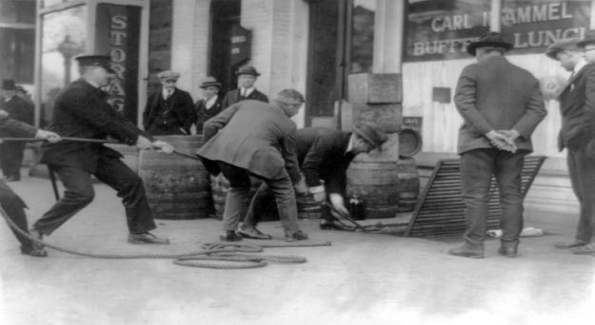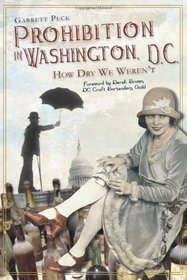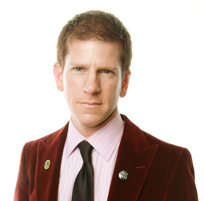The self-proclaimed “history dork” and cocktail aficionado dishes on the sordid secrets of the Prohibition era in DC, spots to grab a great drink in the District and where to find authentic speakeasy sites.
By Kelly A. Magyarics

Garrett Peck covers the illicit alcohol trade in DC during Prohibition in his new book. Here, police carry out a lunchtime raid in the District.
It’s not hard today to find a great drink in DC, including well-made libations at tucked away spots that require you to either to be in the know, or do a little sleuthing, to uncover. The pirate flag flying and cobalt blue light bulb are both signs that Old Town Alexandria speakeasy PX is open for business. Walk to the back of Warehouse District bar The Passenger, and you’ll stumble open a door that leads to the spa-like Columbia Room, Derek Brown’s bar-slash-laboratory that also serves as the ode to the perfectly made cocktail. And on 14th Street, an unmarked door gives way to the dimly lit, sexy vibe of The Gibson.
Flash back eighty years, and the District was equally chock full of clandestine spots to throw back a cocktail, albeit an illegal one. Arlington-based Garrett Peck’s latest book, “Prohibition in Washington, DC: How Dry We Weren’t,” explores DC’s underground in the days of Prohibition. Back then, the town was ruled not by organized crime, but by amateur bootleggers whose hooch was sold and consumed in the town’s estimated 2000-3000 speakeasies and social clubs; congressman spoke publicly about the evils of alcohol yet downed stiff drinks behind House office doors; and U Street’s African American community was humming with the new sound of jazz. In short, it’s a fascinating account of our past. On Thursday, you can celebrate Peck’s release of the book (and raise a toast to the fact that today we can all drink freely and legally) at a launch party/fundraiser at the Woodrow Wilson House (see deets below). I recently asked him about the book and about DC’s cocktail scene, and he also shared a few of his favorite cocktail recipes with me:
Tell me something that surprised you about the Prohibition era when researching this book?
One surprise was how big the brewing culture was in DC. We had four breweries in the city until Prohibition began in the city on November 1, 1917! Two were on Capitol Hill, and two in Foggy Bottom. Brewing was the second largest industry in the city after the federal government. Beer was largely what people drank before Prohibition, but Prohibition killed that beer-drinking culture. The largest brewery, Christian Heurich Brewing Company (now the site of the Kennedy Center), reopened after Prohibition, but Heurich was surprised how low the demand was. People had gotten used to bootleg cocktails during Prohibition, and lost their taste for beer. The brewery closed in 1956.
Another surprise was the views of African Americans about Prohibition. No one has ever looked into what black people thought about Prohibition, so I decided to write a chapter about it called “The Jim Crow Annex.” I felt this was especially important, given that Washington, DC’s population was 25% black at the time, and Prohibition largely coincides with the Great Migration of African Americans out of the Deep South. It was also the era when U Street boomed with jazz clubs, and jazz and cocktails went hand-in-hand. I ended up spending half of my research time on this one chapter: it really took a lot of digging, as the press at the time was segregated, and finding black thought leaders or commentary about Prohibition was difficult. But this is why we have archives, and I dug and dug until I found good primary material. It surprised me how difficult it was to find, but I’m also proud that the information is available. It’s the chapter I’m most proud of.
Tell me one of your favorite tales from the book about the Prohibition era in DC.

Peck's new book uncovers the speakeasies, bootleggers and underground liquor culture during DC's "Dry Years."
I love the story of the Mayflower Club, a swanky speakeasy that was raided three times in the waning days of Prohibition. It’s now the site of Dirty Martin, just south of Dupont Circle. People often ask me if they can visit a speakeasy site. Few are left downtown (most of downtown DC has long since been redeveloped), and many others were in private homes that aren’t open to the public. But the Mayflower Club is one that you can visit, though the actual speakeasy was on the fourth floor, which is the bar’s offices.
Do you think the U.S. will ever be in danger of Prohibition again?
I don’t think so. The culture war against alcohol failed miserably, and no one wants to re-fight this battle. The country moved on. Today, two-thirds of American adults drink alcohol, as shown by the annual Gallup Survey conducted almost every year since 1939. How Americans got over their social stigma against alcohol was the subject of my first book, “The Prohibition Hangover: Alcohol in America from Demon Rum to Cult Cabernet” (Rutgers, 2009).
Talk a bit about the cocktail scene in DC today. Where do you like to go for a good drink?
The DC cocktail scene has gotten significantly better in the past five years, as bartenders and bars have raised their game to make better cocktail. There’s both nostalgia for old-time cocktails, and also a realization among many that fresh ingredients simply taste better. That requires more effort on the part of the bartender than using a pre-mix, but the results are definitely better (though also more expensive).
I’m a big fan of The Passenger, which is cocktail mecca. I also like The Gibson. Adam Bernbach has created exquisite gin and tonics at Estadio. And for watering holes – the places you go just to socialize and have an informal drink – I like Bar Pilar, Cafe St. Ex, and Nellie’s, the gay sports bar on U Street. I still have to try out 9, the new gay lounge on P Street where Halo used to be. It just opened.
What do you like to drink?
I’m very partial toward whiskey, and I love gin cocktails. Whenever I finish a writing project, my go-to cocktail is the Last Word. I’m also a craft beer nut.
Can you share a few of your favorite recipes from the book?
Sure thing. The book has 80 images, 5 neighborhood maps, and 11 vintage cocktail recipes (9 are DC cocktails, and the other two – the Scofflaw and the Coffin Varnish – are certifiably Prohibition-era).
Joe Rickey
The Rickey is DC’s claim to cocktail fame, and the DC Craft Bartenders Guild has sponsored a Rickey Week in July the last few years. The cocktail was invented at Shoomaker‘s on “Rum Row” (14th & Penn, NW) in the 1880s.
1.5 oz. rye whiskey or bourbon
Juice of 1/2 lime
Apollinaris Mineral Water or club soda
Fill a highball glass with three or four ice cubes. Add the whiskey, squeeze in the lime juice, and drop in the shell. Top off with the water.
A couple variations: For a Gin Rickey, substitute gin for the whiskey. This is probably the most popular way people drink Rickeys today, though the whiskey version is more historic. For a Sheeney Rickey, simply omit the lime shell.
Mamie Taylor
Historian George Rothwell Brown claimed that the Mamie Taylor was invented in Washington, DC, but other cities claim it as well. It supposedly was invented at Dennis Mullany’s on Rum Row in 1902.
2 oz. blended Scotch
Juice of 1/2 lime
Ginger beer
Lime wheel, for garnish
Fill a highball glass with three or four ice cubes. Add Scotch, squeeze in lime juice and top with ginger beer. Garnish with a lime wheel.
Tickets are still available for this Thursday’s publication party from 6:30 to 8:30 PM at the Woodrow Wilson House—the event is also a fundraiser for DC’s only presidential museum, and all proceeds will go to help the historic spot. Go to www.woodrowwilsonhouse.org to purchase tickets or Peck’s new book. The $35 ticket to the book opening includes an open bar and hors d’oeuvres. Signed copies of the book are available from Woodrow Wilson House’s gift shop for a special discounted price of $19.07 including tax.
Peck also leads Temperance Tours of Prohibition-related sites in Washington, DC. The next tour is this Saturday, May 21 at noon. It’s a free tour—just show up with a Metro card, water and sunscreen. It lasts about 3 hours, followed by happy hour at the Bier Baron.
Kelly Magyarics is a wine and spirits writer, and wine educator, in the Washington, DC area. She can be reached through her website, www.kellymagyarics.com, or on www.twitter.com/kmagyarics.





